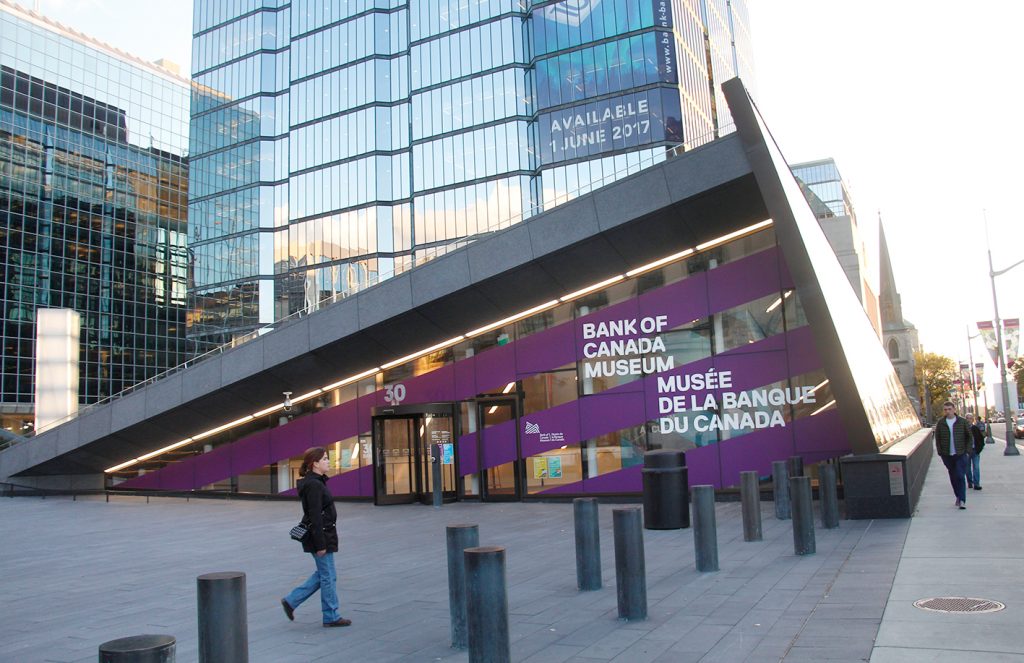Bank of Canada Museum reopens
By Hannah Berge
After four years of renovations, the new Bank of Canada Museum is back — and it’s bringing the history of Canadian commercial culture to the heart of the capital in an interactive way. When the museum closed its doors in 2013, the opportunity was seized for reinvention. The modern-day architectural landmark that emerged — with its sharply angled entrance portal along Wellington Street — now contains a variety of high-tech exhibits, including a popular section that allows visitors to create their own personalized banknote.
The old Currency Museum in the basement of the Bank of Canada primarily gave people the opportunity to look at coins and other old artifacts. Such items are still on display — including ancient coins dating back to 413 BC — but the made-over museum also attempts to teach visitors more about the operations of the bank and economy, and uses interactive exhibits to better engage its audience.
Joseph Atta-Mensah, a former Bank of Canada employee, recently decided to visit the museum to see for himself how it had changed. He said he was impressed at the improvement over the old Currency Museum.
“It’s very high-tech now,” he said. “It’s a much better way of informing citizens about the workings of the bank.”
Atta-Mensah even sat down at the rocket ship station and played the video game that explained a two-per-cent inflation rate in a kid-friendly way.

Perhaps the most popular attraction is the interactive exhibit that allows visitors to create a customized banknote. “People are jazzed by it,” said Ken Ross, museum director.
Visitors can take a selfie for the face on the banknote, choose the colours and shapes, and finalize it with their own signature.
Over the course of four years, Ross and his team visited and worked with museums around the world to help the project come together. He said his biggest influence came from the Interactive Museum of Economics in Mexico City. With help from its CEO, and the Montreal design firm GSM Projects, Ross said his vision became a reality.
“Large institutions like the bank can be intimidating to people,” said Ross. “So I wanted to counteract that with a very friendly and welcoming atmosphere.”
People can create avatars to guide them through the museum, and videos of employees greet visitors and explain to them different aspects of the bank along the way.
“This is a real outreach by the Bank to say, ‘Look we’re here, and you may not know how important we are to you, or how important you are to us, but we want to set you straight on that,’” said Ross.

The refurbished museum has added another significant site to Ottawa’s established tourist attractions. In the past three months since its official opening on July 1 — Canada’s 150th birthday — the museum has drawn about 35,000 visitors, more than the total amount at the former Currency Museum in all of 2012, its last full year of operation.
Catherine Callary, a senior director at Ottawa Tourism, agreed with Ross, and attributes some of that success to the interactive elements the museum now offers.
“Bringing a technologically-driven presentation into play means that information can be presented in new and engaging ways,” she said. “And these are intriguing to younger generations of visitors.”
That said, Ross noted that he’s seen people from ages 5 to 75 playing the interactive games, and creating banknotes.
Callary said the museum’s mixture of new elements, its excellent location and “stunning architectural design” has allowed the museum to flourish. She said it has the ability to entertain everyone, even those not interested in the Bank of Canada.
Ross said the museum is planning to work with educators across the country in the near future to develop programs that will teach citizens about the role of the bank and the nature of the economy.

